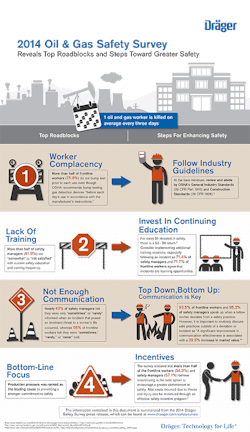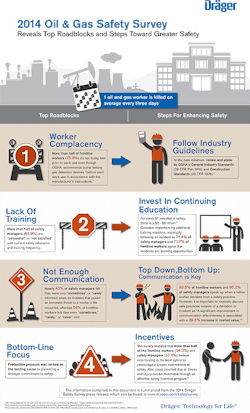Frontline Workers and Safety Managers in the Oil and Gas Industry: Four Roadblocks to Safety
For the first time, a new survey has captured frontline workers’ and safety managers’ personal perspectives on the state of safety within the oil and gas sector. Compiling the viewpoints of 129 self-identified, current and former safety managers and frontline workers, the safety survey from Dräger reveals the leading challenges in maximizing the industry’s safety potential: complacency, training, communication and a bottom-line focus.
The two-part survey revealed a consensus among frontline workers and safety managers that they believe the industry as a whole is committed to safety. The majority of frontline workers (69 percent) and safety managers (61.9 percent) feel their current or previous employers often considered their safety, as well as provided the necessary training and equipment.
Respondents agreed opportunities for improvement exist, with two-thirds of safety managers ranking their current or previous safety culture as “medium,” while a one-third identified it as “strong.” The need to improve the industry’s safety record reflects this startling statistic from the U.S. Bureau of Labor and Statistics indicating that an oil and gas worker is killed on average every three days.
What Are the Leading Safety Roadblocks?
Worker complacency – The survey unequivocally acknowledged worker complacency as one of the greatest inhibitors to enhanced safety. Part one of the survey, which involved speaking with 50 safety managers, revealed 18 percent of safety managers believe it to be the most significant roadblock to greater safety.
Further testament to worker complacency at energy worksites is an unsettling finding from part two of the survey, which polled safety managers and frontline workers. More than half of frontline workers said they do not bump test their gas detection devices in accordance with the recommended OSHA guideline of prior to each day’s use. Only 28 percent conduct it once a week, 8.7 percent twice a month, 6.5 percent at their discretion, 28.3 percent didn’t know and 4.3 percent never perform a test. Comparatively, the majority of safety managers (61.9 percent) conduct bump tests prior to each day’s use, despite monitoring workers who often do not follow this recommended behavior.
Training – The oil and gas industry consistently faces significant challenges as the sector continues to rapidly transform due to ongoing technological advancements. This constant evolution underscores the need for continual education and training to ensure the proper and safe use of safety equipment, as well as a greater understanding of how to react in the event of a life-threatening incident.
Dräger’s Safety Survey found that more than half of safety managers (61.9 percent) are “somewhat” to “not satisfied” with the frequency of safety education and training occurring at their current or most recent worksite.
It also uncovered that 71.4 percent of safety managers and 71.7 percent of frontline workers overwhelmingly agree that incidents are learning opportunities. This point further illustrates that in-the-moment teaching is found to be most effective, even though it is not being conducted regularly in many cases. The survey revealed that 66.7 percent of surveyed safety managers feel hazards and risks only are communicated to them following a life-threatening incident, and 52.1 percent of surveyed frontline workers are “often” or “never” made aware of events, highlighting the lack of learning from hazardous incidents.
Communication – Communication is a key in all businesses, no matter if it’s a corporate office or an oil rig. The survey confirms that talk is not cheap when it comes to alerting fellow workers to safety concerns. Overwhelmingly, both frontline workers (93.5 percent) and safety managers (95.2 percent) responded that they speak up when they observe a colleague deviating from a safe practice.
While workers speak up when an unsafe practice or procedure occurs, the survey revealed that lessons learned may not be passed around the worksite, especially following a life-threatening incident. Nearly 43 percent of safety managers felt they were only “sometimes” or “rarely” informed when an incident that posed an imminent threat to a worker’s life occurred, whereas 56.5 percent of frontline workers felt they were “sometimes,” “rarely” or “never” told.
Bottom-line focus – Most industries are driven by profits, and in today’s economy, companies must maximize productivity while reducing costs. Many survey participants believed this comes at the expense of worker safety. Productivity pressure was ranked as the leading cause to preventing a stronger commitment to safety.
To shift this behavior, companies must place greater focus on recruiting and investing in the right workforce, and in acquiring and training on effective technology. In some cases, there may be efforts made by management to protect the safety of workers that are not being communicated. Consistent and dedicated transparency, dialogue and communication could help correct any misperceptions about management’s dedication to safe production.
To maximize the industry’s safety achievements, Dräger suggested companies showcase their passion for their employees’ well-being from the top down in order for it to radiate throughout the worksite. When companies invest in their people by equipping them with the right technology and training, their people will reward them by maintaining a safe worksite.
About the Author

Sandy Smith
Sandy Smith is the former content director of EHS Today, and is currently the EHSQ content & community lead at Intelex Technologies Inc. She has written about occupational safety and health and environmental issues since 1990.

